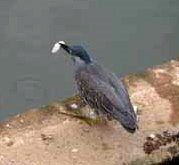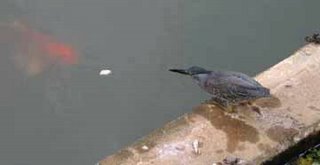Azmi Mohamed was at the Singapore Botanical Gardens on the morning of the 26th February 2006 when he came across the Little Heron (Butorides striatus) doing an unusual thing. “It was picking up pieces of bread and dropping the bread into the water. It appeared to be trying to lure fish within range for it to prey on. Most of the time the bread would be eaten by fish too large for it to prey on. Whenever the bread was eaten by a large fish, the bird would pick up another piece of bread and drop it into the water. I didn’t observe it catching any small fish successfully.”
Intrigued by the behaviour of this Little Heron, Azmi wanted to know whether anyone else observed this behaviour?
Jeremy Lee reported that he was there the last weekend and saw the same heron standing on a water lily leaf doing the same thing. But it did not manage to catch any small fish.
Robert Teo saw the Little Heron in the company of a White-breasted Waterhen (Amaurornis phoenicurus) and some Lesser Whistling-ducks (Dendrocygna javanica) when visitors came to feed the ducks. But he did not see the bird using bread as bait to fish. Robert wonders whether this behaviour is natural or learned from watching the duck feed.
Hung Bun Tang wrote: ”It is well known that the crows are very clever birds. Little Herons, I have seen in a documentary, may just be as clever. They can bait fish. They observed people feeding ducks in a pond and noticed that fish were also attracted to the bread. So they picked up some tiny bits of bread from the ground and dropped them into water to lure the fish. It worked and they got an easy meal! Sometimes they used tiny insects as baits too.”
According to our bird specialist, R. Subaraj, the Little Heron is indeed using bread as bait to fish. This has been observed a few times before at the Symphony Lake, Singapore Botanic Gardens and several times at the Waterbird Lake, Jurong Bird Park. “This little fellow is certainly not “bird-brained” and I believe the key to success for this little chap is learning where to fish, with bait. At the open areas of the Symphony Lake, the larger fish would take all the bread but in the past, these herons have had more success catching smaller fish by placing it in shallower edges of the pond, usually in shady spots.”
Subaraj further added: “David Attenborough’s film crew was keen to film this a few years ago and contacted me but unfortunately the Bird Park’s lake was undergoing renovation then and it was not possible.”
Sharon Chan confirms Subaraj’s statement of the happenings at the Jurong Bird Park. She has this to say: “The pelicans and swans are fed on floating platforms. When they feed, some of the food falls into the water. This in turn attracts the attention of the fish. So you tend to see a lot of fish swimming around the floating platforms. When the swans move away, the Little Heron will stand by the edge of the platform staring intently into the water, looking for their food – the fish.
“There is usually a solitary bird at one platform, waiting for its prey. This is not restricted to the herons. The Spot-billed Pelican (Pelecanus philippensis), and Great White Pelican (P. onocrotalus) have taken this one step further. They actually scoop up some food from the tray and drop it into the water to draw the fishes to them. Then they will collectively dip their bills into the water and the fishing begins…”
In the next episode we will look at what Con Foley has to say after he went Googling – looking for information on this intelligent bird.
Contributed by Azmi Mohamed, Jeremy Lee, Robert Teo, Hung Bun Tang, R. Subaraj and Sharon Chan. Images by YC (top) and Azmi (bottom two).












8 Responses
Kent Ridge Park has a similar one too…. it’s at the small pond. Best time is btw 5:00pm to 7:30pm.
i also saw this!
Its at another park but i forgot
Amazing! I did not know about this behaviour at all. It demonstrates a whole new level of cognition I didn’t know existed in these birds.
You can feed bread to the little heron at MBS ArtScience pond and see him fishing. We do this Sunday mornings around 11am and little heron just drop by to catch our bread. He usually gets his fish but not for the faint hearted.
It would be interesting to video the episode…